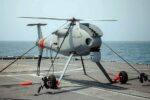At the Association of the United States Army (AUSA) 2025 exhibition in Washington, D.C., Israel Aerospace Industries (IAI) unveiled an upgraded version of its Mini Harpy loitering munition. The latest iteration now incorporates a dual-mode electro-optical/infrared (EO/IR) and anti-radiation seeker, significantly enhancing its versatility in Suppression of Enemy Air Defenses (SEAD) and precision strike roles.
Mini Harpy Evolution: From Niche SEAD to Multi-Mission Loitering Munition
The Mini Harpy was originally introduced in 2019 as a hybrid between IAI’s HARPY anti-radiation drone and the HAROP loitering munition. Designed to combine radar-seeking capabilities with electro-optical targeting, the system aimed to fill a niche role in SEAD operations against mobile or intermittently active air defense systems.
The new configuration displayed at AUSA 2025 marks a significant evolution. The addition of a full-spectrum EO/IR sensor suite alongside the anti-radiation homing capability allows operators to engage both emitting radar systems and visually identified targets such as vehicles or command posts. This dual-mode approach increases mission flexibility in complex environments where enemy radars may be silent or decoys are deployed.
Technical Specifications and Payload Enhancements
According to IAI materials and corroborated by industry sources at AUSA 2025, the upgraded Mini Harpy features the following key specifications:
- Wingspan: ~1.4 meters
- Length: ~1.2 meters
- Weight: ~45 kg launch weight
- Endurance: Up to 2 hours loiter time
- Range: Estimated operational radius of over 100 km
- Warhead: High-explosive fragmentation warhead (~8–10 kg)
- Sensors: Combined passive RF seeker for radar homing + EO/IR gimbaled sensor for visual targeting
The integration of both sensor types into a compact airframe required significant miniaturization efforts. Notably, the dual-seeker configuration allows real-time operator intervention via man-in-the-loop control during terminal phase engagement when using EO/IR mode—while retaining autonomous strike capability against predesignated emitters using passive RF homing.
Tactical Roles and Operational Use Cases
The upgraded Mini Harpy is tailored for modern battlefield conditions characterized by contested electromagnetic environments and dispersed targets. Its primary mission remains SEAD—neutralizing surface-to-air missile (SAM) radars such as those from Pantsir-S1 or Buk-M systems—but it can now also engage non-emitting targets based on visual confirmation.
This makes it suitable for roles including:
- SEAD/DEAD: Engaging active or recently active radar systems
- Tactical ISR-strike fusion: Using onboard sensors to identify and strike high-value targets like C2 nodes or artillery positions
- A2AD penetration: Operating ahead of manned aircraft to degrade enemy air defenses
- Urban warfare support: Precision strikes on visually confirmed threats while minimizing collateral damage
The ability to switch between autonomous RF homing and human-in-the-loop EO/IR targeting is particularly valuable in environments where adversaries employ radar silence or spoofing tactics.
Launch System and Deployment Flexibility
The Mini Harpy is canister-launched from ground-based platforms, vehicle-mounted racks, or potentially naval vessels. Each sealed container includes all necessary launch electronics, enabling rapid deployment without extensive ground infrastructure.
This modularity supports swarm-style saturation attacks or distributed launches from multiple directions—a tactic increasingly relevant against integrated air defense systems (IADS). Multiple munitions can be launched simultaneously with coordinated flight paths managed via ground control station software.
Strategic Implications for Export Markets and Allied Forces
The upgraded Mini Harpy aligns with growing global demand for cost-effective loitering munitions capable of operating in GPS-denied or EW-contested environments. Its dual-mode seeker offers redundancy against countermeasures that might defeat single-sensor drones.
Nations facing advanced Russian- or Chinese-supplied SAM threats—such as Ukraine, Taiwan, Poland, or Baltic states—may find particular value in this system’s SEAD capabilities. While IAI has not confirmed specific export customers for the upgraded variant as of October 2025, previous versions have drawn interest from India and other Asia-Pacific partners.
AUSA Showcase Reflects Broader Trend Toward Multi-Sensor Loitering Munitions
The reappearance of Mini Harpy at AUSA underscores a broader trend within Western-aligned defense industries toward multi-mission loitering drones. Similar developments include AeroVironment’s Switchblade X series with advanced optics integration and Rheinmetall’s HERO family co-developed with UVision.
This convergence reflects lessons learned from conflicts such as Ukraine—where FPV drones have proven effective but limited by range/sensor quality—and emphasizes the need for scalable systems combining autonomy with operator oversight.
Conclusion: Compact but Capable SEAD Asset for Future Conflicts
The enhanced Mini Harpy demonstrates how compact loitering munitions are evolving beyond niche roles into versatile battlefield assets. By combining passive RF homing with real-time visual targeting via EO/IR sensors—and packaging it into a lightweight canister-launched platform—IAI positions this system as a viable tool for modern SEAD campaigns under contested conditions.









